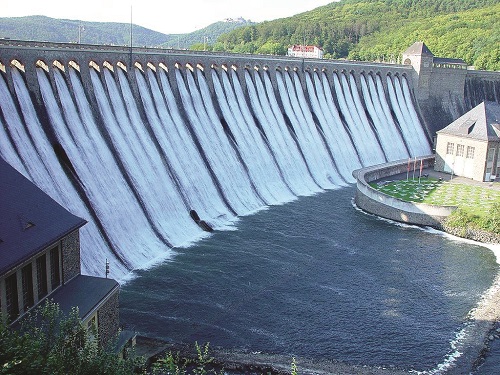
Himachal Pradesh is situated in the northern parts of our country with pleasant mountains, perpetual snow peaks, beautiful crystal lakes, flourishing valleys, rocky ravines, pretty flowering meadow, ancient shrines and promising tourist spots. It shares boundaries with Jammu & Kashmir in north-west, Punjab in south-west, Haryana in south, Uttaranchal in south-east and Tibet/ China in north-east. Enveloped by Pir Panjal & Dhauladhar ranges in north-west, dominated by great Himalayas in north & east and marked with lower ridges of Shivalik ranges in south-east, it is situated in almost wholly mountainous of northern parts of India with high altitudes varying from 350 m to 6975 m above mean sea level stretched over an area of 55,673 km2 with population of 68, 56,509 (population density 123 persons/ km2) as per 2011 census.
Major source for power generation in Himachal Pradesh is hydro power followed by other non-conventional sources of energy. In addition, Himachal Pradesh has also share in central sector coal/ gas based thermal power stations and nuclear power generation.
Himachal Pradesh is blessed with significant potential for hydro electricity generation due to thawing of glaciers and frozen lakes. Fed from five mighty snow-fed rivers (Chenab, Ravi, Beas, Sutlej & Yamuna) emanating from western Himalayas, state is endowed with a vast hydropower potential of about 18,540 MW (with station installed capacity over 25 MW), which is equivalent to 1/8th of the total hydro power potential assessed in India. Out of this, 52% has been developed and 11 % is in the process of development. State has the largest capacity hydropower station (1500 MW), the largest unit size (250 MW), the largest underground power house cavern and the longest tunnel in operation in the country at Nathpa Jhakri. State also has third highest head hydropower station (Bhava-887m) in operation.
Paper highlights in brief the power supply position, river systems, hydropower potential & status of development, hydropower stations with individual installed capacity over 25 MW in operation or under construction or under survey & investigations and renovation & modernization, up-rating and life extension in Himachal Pradesh.
Power Supply Position
In Himachal Pradesh, there has been a shortage in energy by about 1% during August 2017 and April 2017 to August, 2017. However, peak power demands have been met during these periods. Requirements vis-à-vis availabilities of electricity and peak power demands in Himachal Pradesh during these periods are given in Table 1.

Sources of Electrical Energy
Major sources of electricity in Himachal Pradesh are hydro power plants followed by renewable sources (RES) under Ministry of New & Renewable Energy (MNRE). The state has also shares from thermal (Coal & Gas) and Nuclear power plants of Central Sector. Total installed capacity of electricity in Himachal Pradesh on 31.08.2017 is 3896.22 MW. Sector-wise and category-wise distribution of installed capacity in the state is indicated in Table 2.
In addition to above, Himachal Pradesh has micro/ mini/ small hydro power stations in operation and under construction. From above, it is seen that contribution of hydro installation to total installation in the state is 71.8%. Since hydro power is the major source of power in Himachal Pradesh, hydro power developed is covered in the following paragraphs.

River Systems in Himachal Pradesh
Himachal Pradesh has two perennial river systems fed by snow and rainfall, viz. Indus River System (Sutlej, Beas, Ravi, Chenab/ Chandra Bhaga & Jhelum rivers and their tributaries) and Ganga River System (Yamuna & its tributaries). Sutlej River originates from Mansarovar Lake in distant Tibet, cuts through great Himalayan & Zaskar ranges & travels 350 km in Tibet, crosses Indo-Tibetan border near Shipkila at 2530 m elevation and continues to flow in Himachal Pradesh through Wangtoo and Kian before emerging at Bhakra. Its principal tributaries below Shipkila are Spiti, Kashming, Baspa, Bhava, Nogli, Korpan, Nauti, Sholding, Sear, Bharavi, Ali and Ghamber. It has a fall of 2180 m from Shipkila to Bhakra and catchment area 56,875 km2 (36,875 km2 in Tibet, 20,000 km² in India). Catchment area is dominated by monsoon precipitation from June to September (48% of annual precipitation). In upper reaches, only small rainfall occurs in winters.
Ravi is formed by glacier Bhadal and Tantgari of Himalayas near Rohtang Pass & Bara-Bangahal in Kangra district of HP in snow covered peaks at an elevation of 4000 m, travels 240 km and enters into Pakistan at an elevation of 255 m after crossing Shiwaliks and then Punjab at Madhopur. Kalihen, Holi, Kuarsi, Budhil, Tundah, Siul, Sewa and Ujh are its major tributaries draining catchment areas ranging between 78 km2 to over 1500 km2 (Siul has largest catchment area 1515 km2). Entire basin lies within India and drains a catchment of 8256 km2 in Himachal Pradesh, Punjab and J&K. Part of basin remain frozen throughout year. Main river/tributaries are perennial because they are fed from snow/glaciers. Annual rainfall is 600-1600 mm. Being one of eastern rivers; Ravi has no restriction for constructing storage under Indus Water Treaty.
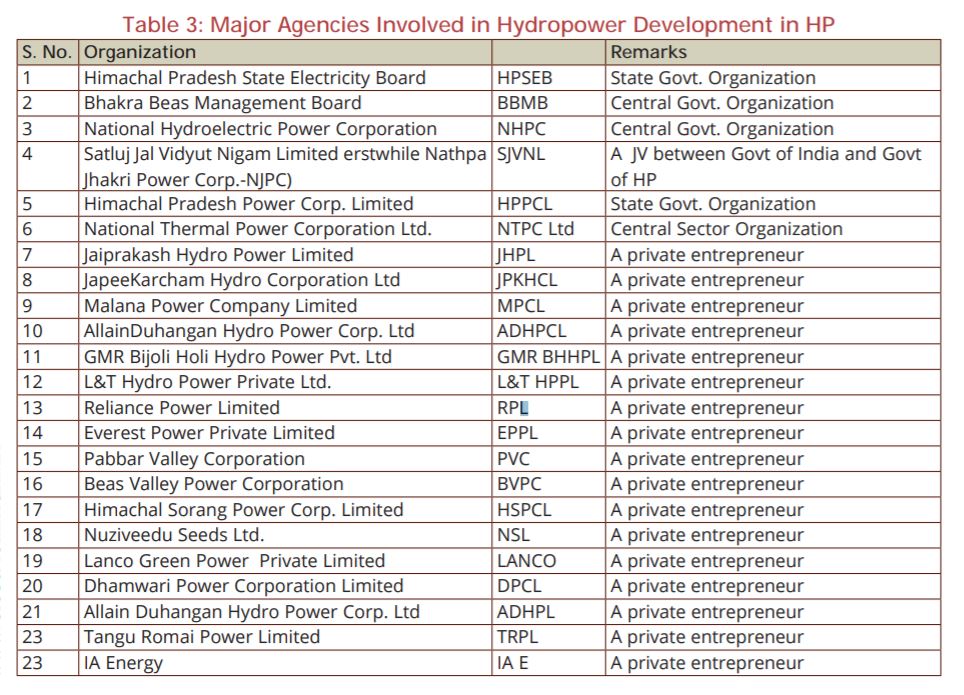
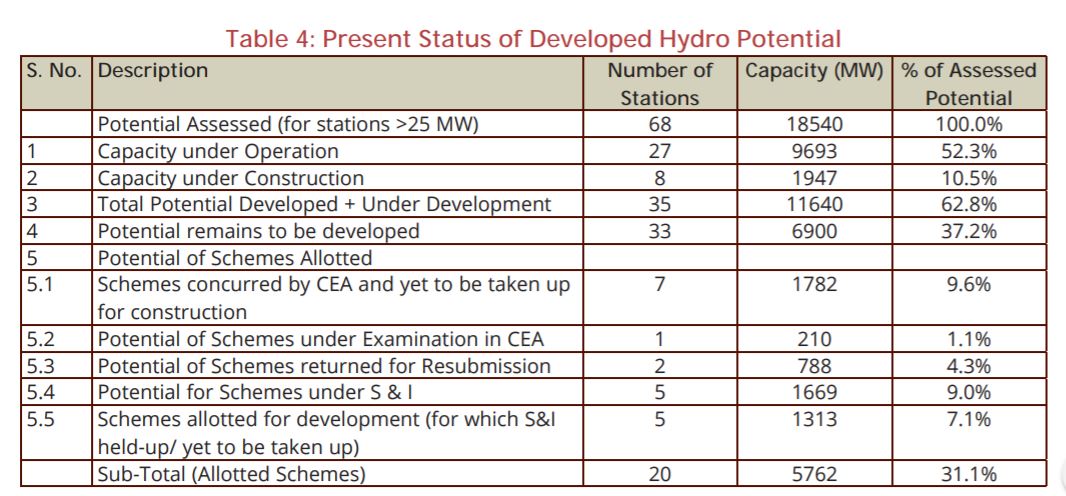
Beas originates from Kunderi Dharin Pir Panjal range near Rohtang Pass/Hanuman Tibba in Himalayan Hills at an elevation of 4870 m in Himachal Pradesh, traverses 370 kms, enters into plains of Punjab and meets Sutlej at Harike after Pong. It has many tributaries, of which 18 can be considered for economic hydropower development. Its tributaries Malana, Sarvari, Fozal, Uhl, Binwa, Rana, Neogal, Baner and Gaj meet it from right and Allain, Duhangan, Pankhoj, Parbati and Sainj meet from left draining catchment areas 40km2-1500 km2 (Parbati has largest catchment1520 km2). Entire basin lies within India and drains a palm shaped catchment of 18210 km2 in HP & Punjab. Apart from heavy rainfall, catchment is also fed from a number of glaciers and snow catchment making rivers/ tributaries perennial. Annual rainfall varies from 800-1000mm in upper reaches and 1000-1600 mm in lower reaches. Beas is one of western rivers and thus has no limitations for providing regulatory facilities under Indus Water Treaty.
Chenab or Chandrabhaga or Askniis formed by confluence of Chandra and Bhaga rivers at Tundiin Lahaul. It originates at 5080 m elevation from Baralachha Pass. In terms of flowing water, it is the biggest river in Himachal Pradesh with drainage area 28,748 km2 (23,400 km2 in India) upto Marala in Pakistan. Major portion of basin in upper reaches remain frozen throughout the year and is fed by many glaciers, which make them perennial. Yamuna originates in Yamunotri in Uttarkashi district of Uttarakhand and passes through Himachal Pradesh. Its total catchment area in Himachal Pradesh is 2320 km². Its tributaries are Tons, Giri and Bata.
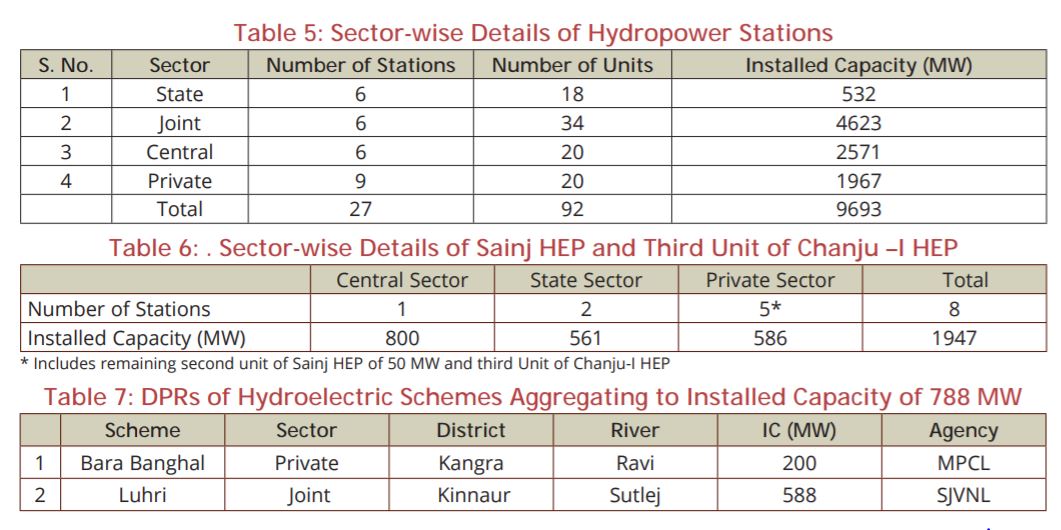
Historical Background of Hydro Power Development in HP
Himachal Pradesh has been pioneer states for hydropower development. Two small/mini hydro schemes Jubbal (50 kW) and Bhura Singh/ Chamba (170 kW) were in operation in Pre-Independent India. Unit-1&2 35 kW each & Unit-3 (100 kW) of Chamba were installed in 1904 & 1938 in erstwhile east Punjab. Shimla Hydroelectric Project on Nauti Khad, a tributary of Sutlej was constructed in 1913. Uhl-II/ Shanan (4×12=48 MW) installed in 1932 in erstwhile Punjab also came in Himachal Pradesh during 1966 after reorganization of states. Its units have been up-rated to 15 MW each and an extension unit of 50 MW has also been installed in 1982. However, Shanan has been given on lease to Government of Punjab by Govt of HP.
Survey and investigations of Sutlej were carried out during pre-independence period. As a result, execution of Bhakra Dam Project was taken immediately after Independence. Bhakra Left (after uprating 540 MW) and Bhakra Right (after up-rating 785 MW) projects were commissioned during 1960-68. Bassi (60 MW) and Giri Bata (60 MW) were installed during 1970-1881 and 1978. Pong (396 MW) on Ravi and Dehar (990 MW) on Beas Sutlej link were commissioned during 1977-83. Baira Siul (180 MW), Sanjaya (120 MW) and Chamera-I (540 MW) were commissioned during 1980-1981, 1989 and 1994. Chamera-II (300 MW), Nathpa Jhakri (1500 MW) and Larji (126 MW) were commissioned during the period 2000-2010.
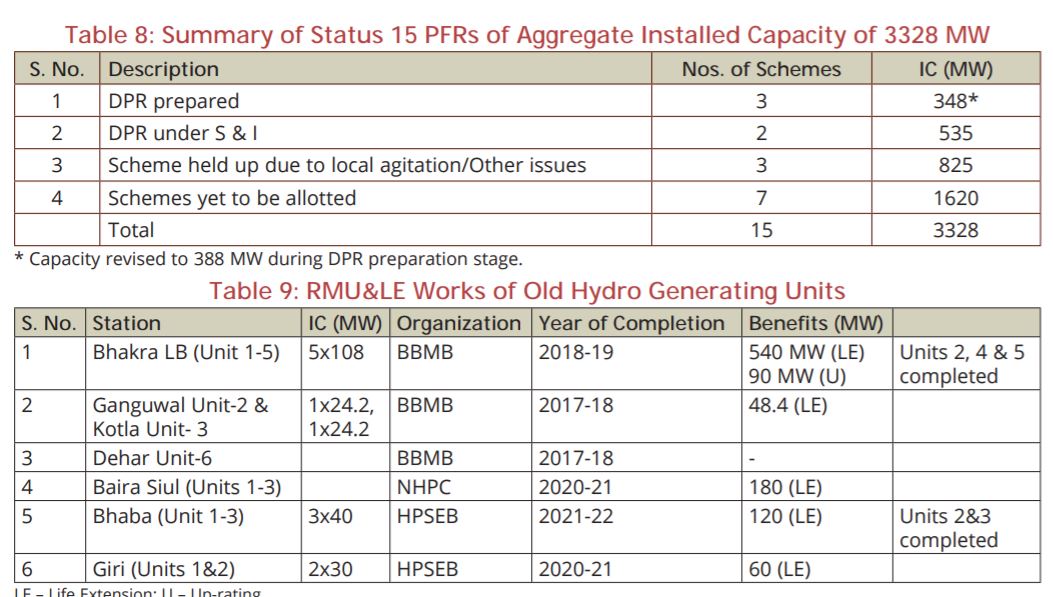
Above projects were executed in central, joint or state sectors. Malana (86 MW) (the first IPP hydro project in HP) and Baspa (300 MW) were also commissioned in private sector during 2000-2010. Malana-II (100 MW), Karcham Wangtoo (1000 MW) (the largest private sector hydro power project in India), Allain Duhangon (192 MW), Budhil (70 MW), Kasang I, II & III (195 MW), Chanju-I (24 MW), Rampur (412 MW) in joint sector and Koldam (800 MW) in central sector were commissioning during 2010-2017. At present total installation in hydro stations in state having individual station capacity over 25 MW has risen to 9693 MW.
Agencies for Hydropower Development
As an organization of power utility, first Electrical Division in HP was formed in August, 1953 under Public Works Department. Subsequently, Multi-purpose Projects & Power (MPP&P) Department was formed in April, 1964 after realizing need for exploiting substantial hydro potential available in rivers. Thereafter, State Electricity Board was formed in 1971 in accordance with the provisions of Electricity Supply Act (1948). Accordingly, functions of MPP&P Department [(generation, execution of hydroelectric projects (excluding flood control & minor irrigation)] were transferred to the Board. Presently, Central Organizations viz. NHPC Limited & NTPC Limited, a Joint Venture Organization viz. SJVNL (earlier NJPCL) and a number of private power entrepreneurs are involved in hydropower development in the State. All census villages have been electrified. Left out hamlet is being covered. Punjab, Haryana, Chandigarh, Delhi, Jammu & Kashmir, Rajasthan and UP are also buyers of power from HP.
In addition to above, there are some other private entrepreneurs involved in development of small/mini/micro hydropower projects in H.P. with station installed capacity up to 25 MW.
Hydro Power Potential in HP & Status of Development
As per the study on reassessment of hydroelectric potential in India carried out by Central Electricity Authority during period 1978-1987, total hydro potential in Himachal Pradesh in terms of installed capacity is assessed at 18,540 MW in stations with individual station capacity >25 MW, which is 12.76% of total hydro potential in India. Present status of developed hydro potential is given in Table 4.
In addition, 2 pumped storage schemes [Mirja (1800 MW and Renuka (1800 MW)] with an aggregate installed capacity of 3600 MW have also been identified for installation in Himachal Pradesh. These schemes are still under planning stage.
Hydroelectric Stations in Operation
27 hydro stations (individual station capacity > 25 MW) housing 92 generating units with an aggregate installed capacity 9693 MW are in operation in Himachal Pradesh. Station-wise details are given at Annex-1. Sector-wise details are given in Table 5.
Hydro Power Projects Under Construction
As on 31.08.2017, following 8 hydropower projects (Station Capacity>25 MW) and remaining second unit of Sainj HEP and third Unit of Chanju –I HEP with an aggregate installed capacity of 1947 MW are under construction in Himachal Pradesh. Station-wise details of these projects are given at Annex-2. Sector-wise details are given in Table 6.
Future Hydroelectric Schemes
Schemes Concurred by CEA & Yet to Be Taken up For Construction
As on 31.08.2017, seven schemes (individual station capacity > 25 MW) aggregating to 1782 MW have been concurred by CEA and are yet to be taken for construction after getting clearances from Ministry of Environment & Forest or other reasons. All of these schemes are to be implemented in private sector. Scheme-wise details of these schemes are given at Annex-3.
Scheme under Examination in CEA
As on 31st August, 2017, detailed project report (DPR) of one hydroelectric scheme, viz. Luhri Stage-I (2×80 + 2×25 = 210 MW) submitted in CEA by SJVNL for execution in Joint Sector is under examination.
Schemes Returned by CEA to Project Authorities for Resubmission
As on 31st August, 2017, DPRs of following two hydroelectric schemes aggregating to an installed capacity of 788 MW submitted in CEA for concurrence have been returned by CEA for resubmission after compliance of comments of CEA/ CWC. (Refer Table 7.)
Schemes under Survey & Investigation
As on 31.08.2017, five hydroelectric schemes aggregating to an installed capacity on 1669 MW are under survey and investigation in Himachal Pradesh (Detailed at Annex-4).
Schemes for which S&I held-up/ yet to be taken up
As on 31.08.2017, survey & investigations for five hydro schemes aggregating to an installed capacity of 1313 MW have been held up/ yet to be taken up for S&I (Detailed at Annex-5).
Hydroelectric Schemes under 50,000 MW Initiative
Under the Programme launched by Prime Minister of India on 25.05.2003 for preparation of Preliminary Feasibility Reports (PFRs) of hydroelectric schemes under 50,000 MW Hydroelectric Initiative, FPRs for 15 schemes with aggregate installed capacity of 3328 MW were prepared for HP. Out of these, PFRs of 13 schemes of 2692 MW were prepared by HPSEB and PFRs of remaining two schemes of 636 MW were prepared by SJVNL. These schemes would be run-of-the river and would have Francis turbine, except Pelton at Tidong-II.
Status of 15 PFRs of aggregate installed capacity of 3328 MW prepared under 50,000 MW Hydroelectric Initiative is given at Annex -6. Summary of status is indicated Table 8.
Renovation & Modernization, Up-Rating & Life Extension
For optimization of resources and to tide over the shortage of electricity in country, Renovation & Modernization, Up-rating and Life Extension (RMU&LE) of existing old hydroelectric power projects is considered a cost effective option to ensure efficiency, better availability and also to augment capacity addition. RMU&LE works of old hydro generating units at the following hydro power stations mentioned in Table 9 in Himachal Pradesh is being implemented.
Conclusion
Himachal Pradesh is blessed with a large hydroelectric potential of 18540 MW. 52.6 % of this has been developed so far and another 10.2% is under development. Thus, there is a need to accelerate the process of development of the remaining 37% of potential in the state. This would not only help in increasing the electricity availability in the state, but also would be beneficial in supplying the increasing demand of electricity of northern grid as well as the national grid.
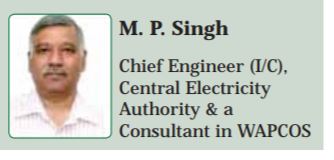
If you want to share thoughts or feedback then please leave a comment below.
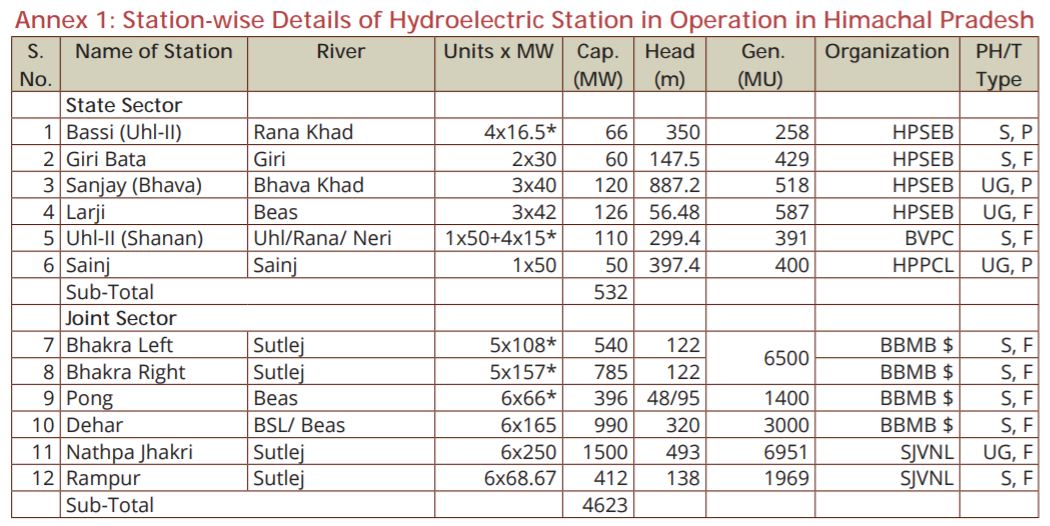
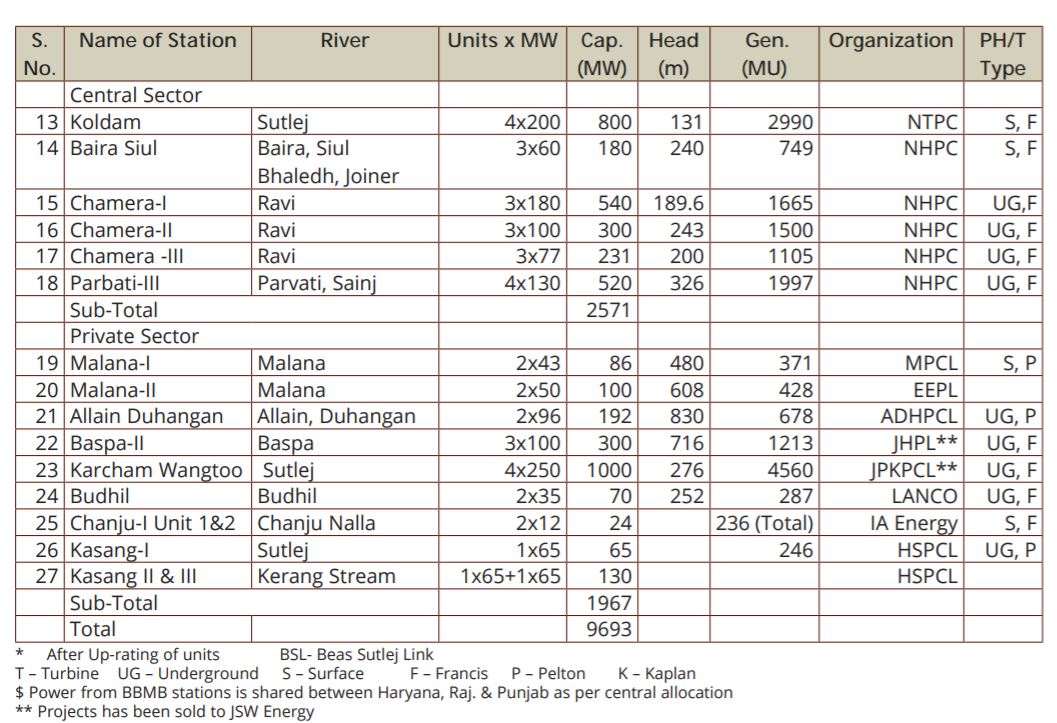
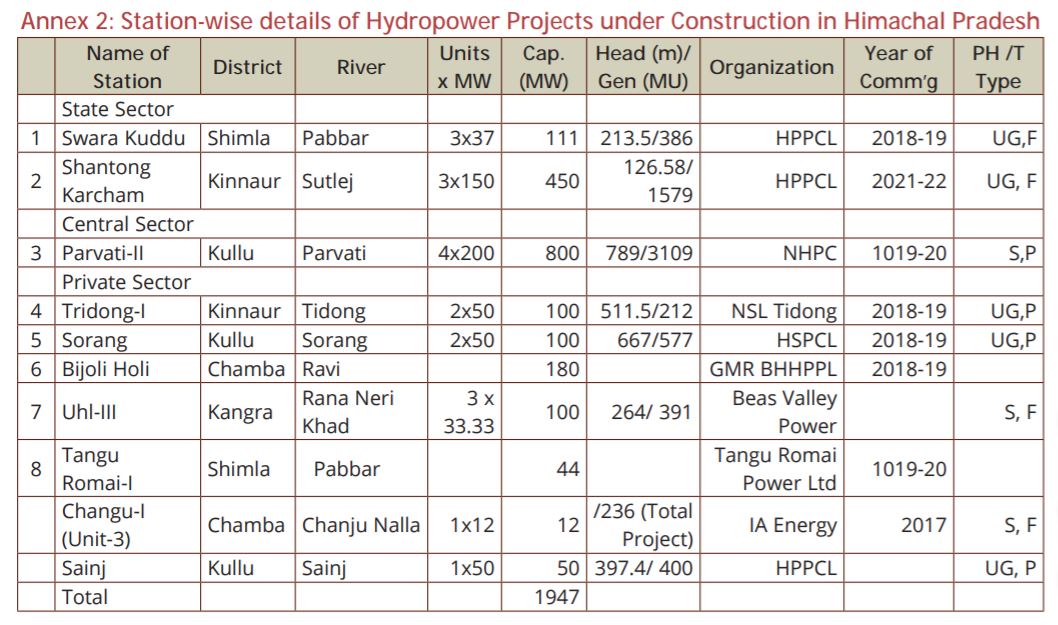
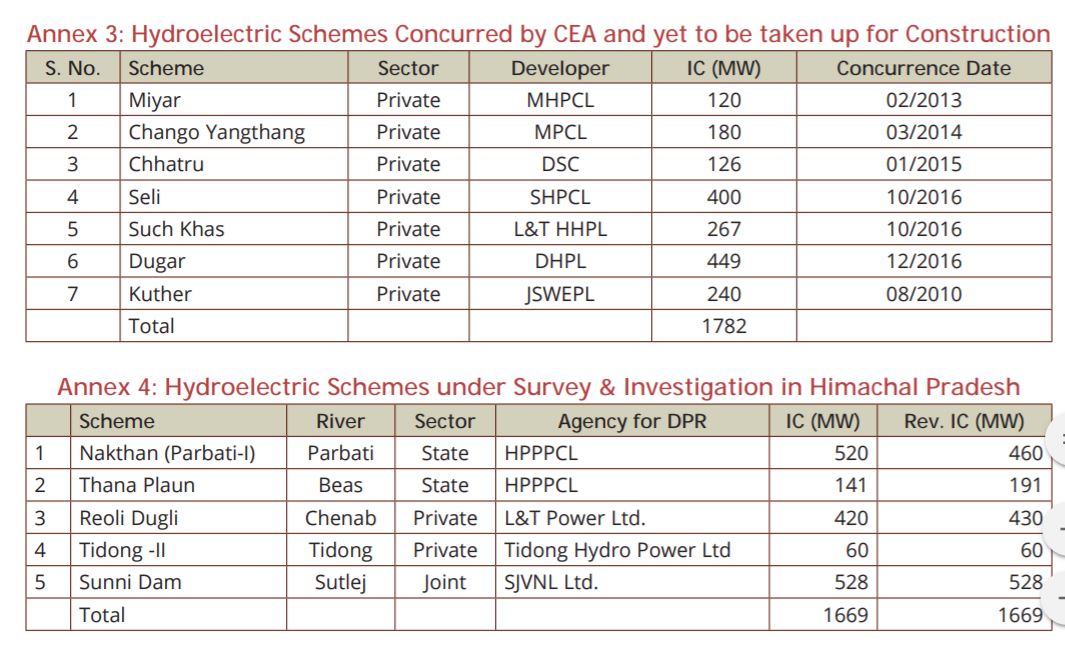
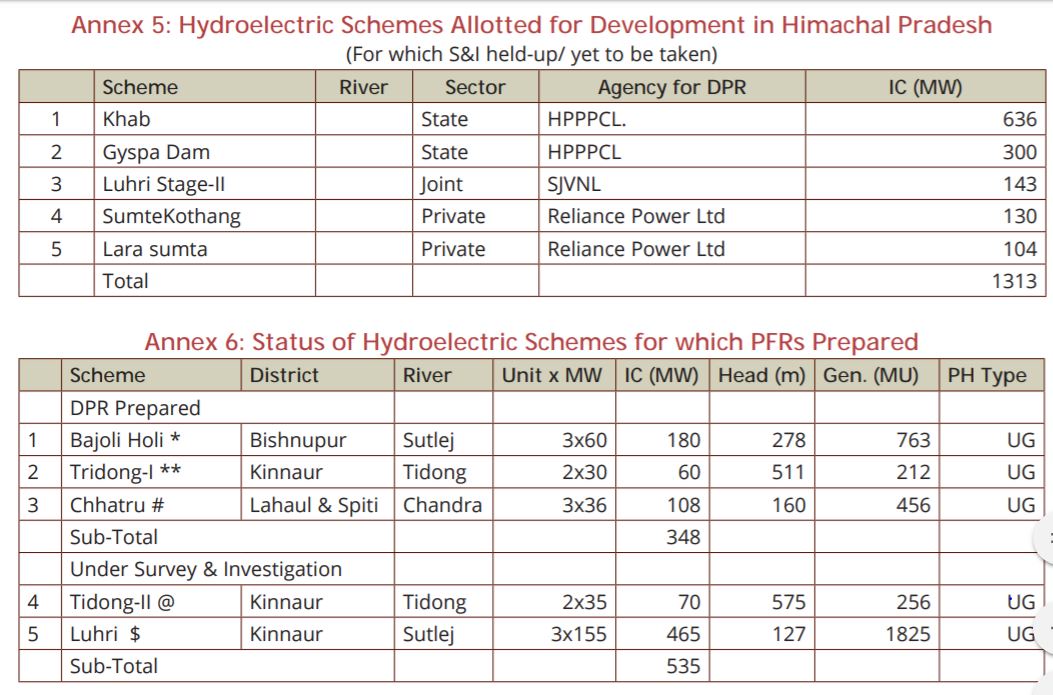
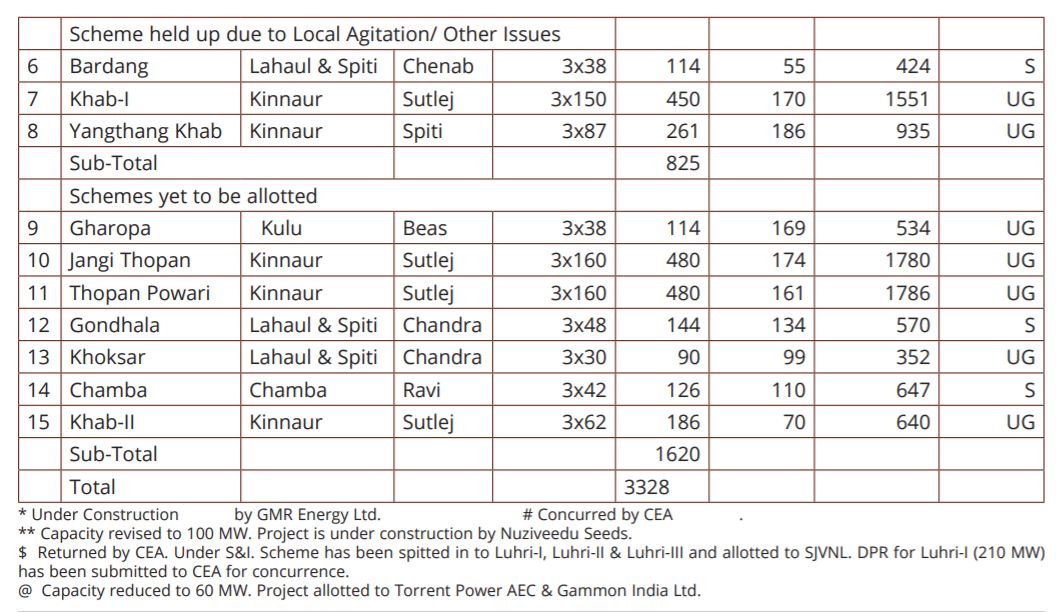


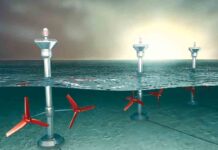


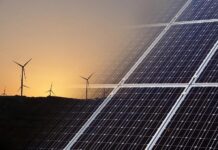

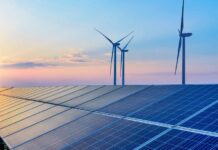
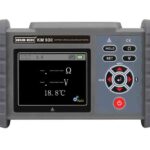
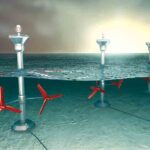
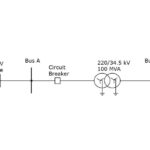








Most helpful
I dont know if I see where you are comming from, but do indeed elaborate a little more. Thanks